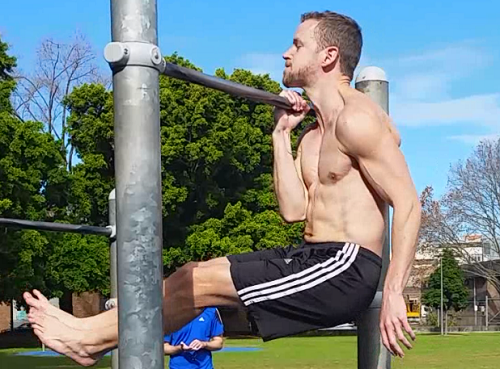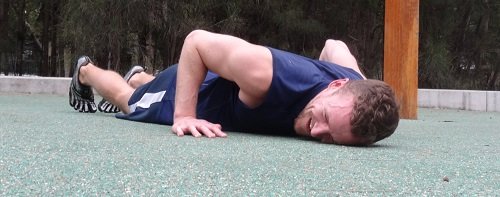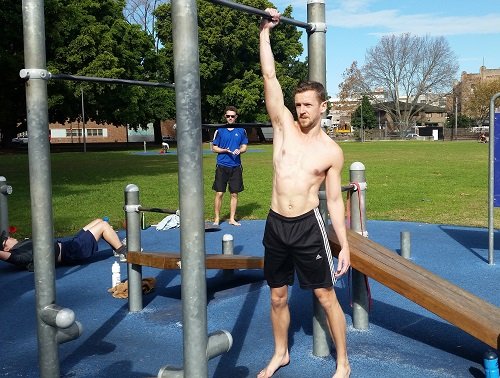Strength Training
Want to learn the secrets to gaining true superhuman calisthenics strength?
If your main goal is big show off muscles that can’t lift anywhere near what they should, then this isn’t the post for you.
Strength training is about allowing you to lift the heaviest you can, or perform advanced feats of bodyweight strength.
Obey these rules and you will see the best strength gains you’ve seen in your life!
The Science Behind Strength Training
Looking for a much more in-depth article about why these rules work the way they do?
This in-depth article on how to gain muscular strength with calisthenics goes through all the major factors affecting strength gains and how you can maximise them.
1. Keep Your Reps Low
3-5 reps are the optimal number of reps for gaining strength.
The reason for this is our strongest energy source is APT-PC. This only lasts for about 10-15 seconds.
After that, we use anaerobic energy sources, which aren’t as strong.
Therefore we should keep our reps in the ATP-PC energy zone.
Furthermore, we want to maximise the gains we get in improved inter and intramuscular coordination.
2. Lift Heavy
Or the bodyweight equivalent, which is to do the hardest progression you can manage.
The body needs to be put under a strain it isn’t used to so that it’s forced to adapt.
Therefore, doing 3-5 reps of an exercise that you can do comfortably will achieve very little.
Go for an exercise that will push you to your limits!
3. Keep Your Sets High
In order to get stronger, we must teach our nervous system the movement.
The more familiar with the movement the nervous system is, the more efficiently it will perform the movement.
For that reason, we must repeat the movement many times.
To do this with low reps, we must go for higher sets.
Aim for at 5 sets, go higher if possible without losing form.
If you have the time, then grease the groove and perform sets all day.
Practice, practice practice!
4. Take Rest Periods of at Least Three Minutes
It takes ATP-PC about three minutes to fully replenish.
If you try training the same muscle before this time, the results will not be as good as the previous set.
Your body also needs time for nervous system fatigue to recover.
Therefore, we should wait a minimum of three minutes before exercising the same muscles.
5. Focus on Specific Movements
If your goal is to do a one-arm pull-up then focus on specific progressions towards that goal.
Isolating the bicep, for example, will get you stronger at flexing your bicep.
It won’t get you stronger at extending your shoulder at the same time as flexing your bicep.
Focus on easier movements that use all the required muscles for your goal at the same time.
6. Avoid Muscle Failure
Training to failure is where you do one too many reps of an exercise and can’t complete the last one.
This can be useful for building muscle mass, to completely exhaust the muscle so that it builds bigger.
However, if your goal is to get as strong as possible you should avoid this.
Training to failure is very taxing on the nervous system. Thus requiring more time to recover.
7. Apply Progressive Overload
The basic rule of any fitness program.
If you keep lifting the same weight, or doing the same progression what do you think the results will be?
Will you get stronger, or simply maintain what you’ve already got?
The answer is no, you won’t get stronger!
You could even go backwards, as the body is no longer requiring any positive adaptions.
Once you can do 3 reps of good form, then make the exercise more difficult.
8. Avoid Using Momentum
Our muscles have what we call the stretch reflex.
Meaning that when a muscle is lengthened quickly, it will automatically flex to stop it from lengthening further.
This is useful when you roll your ankle as it could stop a potential fall or broken bone.
It can also be used to tremendous effect with power training, by using the reflex to quickly fire yourself back from where you came.
This is why the second rep of a muscle-up is easier than the first or box jumps are easier if you take a small step first.
For strength training, we should avoid using our stretch reflex or momentum.
This is because it will reduce the load the muscle has to lift, meaning we’re not as strong as we think we are.
To avoid this, simply stop for one second at the bottom of each exercise.
9. Warm-up
Warming up, love it or hate it, it is not something that we should skip.
It does more than just to get the body warmer.
It gets the nervous system ready for your big lift; by performing smaller lifts using the same muscles.
For example, if you’re going for a one-arm push-up, then perform some regular push-ups first.
If you’re going for your deadlift, then do some short bridges first.
This brings us nicely into the next rule.
10. Visualise The Movement
I have a routine that I perform before I attempt my one-arm pull-up.
First I grab the bar with one arm.
Then I take a few deep breaths whilst psyching myself up and imagining performing the perfect one-arm pull-up.
Finally, I pull myself up.
Why do this?
Just by thinking about a movement, your nervous system will get ready for that movement.
This means your heart rate will increase.
The connections between muscle and brain that have been established through practice will get ready.
Your adrenaline will increase.
All these things help your body prepare for the movement.
11. Include Power Training in Your Plan
To get true strength we should have some power training in there too.
Power is made up of your strength combined with the speed that you can move.
It is activated by our type 2B muscle fibers, whereas strength training uses type 2A.
These are both types of fast twitch fibers.
The more you train fast twitch fibers, the better your body becomes at using them.
To get a truly strong body, we should use both 2A and 2B.
12. Switch Progressions to Avoid Plateaus
If you perform the same exercises again and again, then your body may stop adapting and plateau.
This can happen even if you’re attempting to lift heavier each time.
There are a few ways to get through plateaus.
The main one that I use is to switch progressions.
For example, when I plateaued with my band-assisted one arm pull-ups, I switched to one arm flex hangs.
This gave my body a new adaption and I improved with this quickly.
For weight-lifting, you may try an incline bench press if you plateau on the standard bench.








9 Responses
Wow, another great and useful information Dave. I am currently NASM certified Elite Calisthenics Specialist and am about 3 months away from taking my exam to be a NASM certified personal trainer. There was key information that I was looking for, you explained that really well, thank you.
Glad it was of use mate :) Sounds like I’m in similar situation to you, I’m PCC certified and about 2 months away from completing my PT course. Best of luck with it mate.
Yes. Five sets of five reps.
5×5 is good for strength, I like using 8 sets of 3 to maximise strength though, as you can get similar amount of total reps but with more rest. It’s important to mix up your reps and sets though, I’m currently using 5×5 and 3 sets of 12.
Pavel Tsatsouline advices sets of five (instead of 3). otherwise, anything there is ok with Pavel’s training.
I have also suggested 5 sets in this article, do you mean reps?
hi dave thanks for this tutorial i just want to ask, if i will do 6 kinds or types of push up shall i finished each exercise in 5 sets before doing another type or can i make the 6 exercise first for 1 set and repeat all for anther sets, thank you again
Hi Cris, for maximum strength gains I’d limit the types of push-up to just one or two max. That way you will be stronger for that one exercise. For example, one day I work on my one arm push-up progressions, another I work on my handstand push-up progressions, but rarely on the same day. However if you’re going to do this, I’d advice doing 1 set of each before moving onto the next set, then at least the different varieties will give some muscle a small amount of rest.